
Glossary
Glossary
Access control - is a system which allows controlled access to areas and resources in a given physical facility or computer-based information system.
Americans with Disabilities Act (ADA) - The Americans with Disabilities Act (ADA) gives civil rights protections to individuals with disabilities. It guarantees equal opportunity for individuals with disabilities in employment, public accommodations, transportation, State and local government services, and telecommunications. A US federal law dealing with minimum standards of building accessibility, as well as other issues concerning individuals with disabilities. This landmark legislation provides for stiff civil penalties for any business, workplace, or public institution that fails to provide appropriate access to disabled persons.
American National Standards Institute (ANSI) - ANSI facilitates the development of American National Standards (ANS) by
accrediting the procedures of standards developing organizations (SDOs). These
groups work cooperatively to develop voluntary national consensus standards.
Accreditation by ANSI signifies that the procedures used by the standards body
in connection with the development of American National Standards meet the
Institutes essential requirements for openness, balance, consensus and due
process.
Auxiliary Dead Latch. A plunger which, when actuated, automatically locks a projected latch bolt against return by end pressure.
BHMA is the only U.S. organization accredited by the American National Standards Institute (ANSI) to develop and maintain performance standards for builders hardware. At present there are 31 ANSI/BHMA standards, with several more in development.


 B
B
Backset - The distance from the edge of the door to the center line of the prep in the door. In the U.S. there are two common backsets for residential door locks, 2-3/8" and 2-3/4". Dummy sets have no latch and are surface mounted so you can install a dummy set wherever you choose on the door.
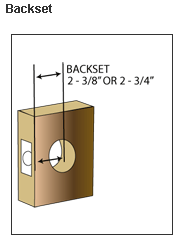
Builders Hardware Manufacturers Association (BHMA) - the trade association for North American manufacturers of commercial builders hardware
Bolt - The projectile member of a lock or latch mechanism that engages the door frame and the strike.
C
Cam - A rotating eccentric piece attached to the end of a cylinder plug to actuate a lock or latch mechanism.
Chassis - The body of the lock itself, without any trim.
Cylinder - The portion of a lock containing the plug with keyway and a body with the pin tumbler mechanism. The properly cut key allows the cylinder to rotate the driver mechanism which unlocks the lock. The two types of cylinders, the mortise cylinder (round, threaded housing) and the bored lock cylinder (sometimes called a cylinder insert), which both provide the same functional value of security and convenience and are often included in the same keying system. (See keying.)
D
Deadbolt - A bolt operated manually and not actuated by springs. When locked, the bolt cannot be forced back. A deadbolt is operated (projected and retracted) by a key cylinder or lever handle.
Deadlatch - A latch in which the latchbolt is positively held in the projected position by an auxiliary mechanism.
Door Closer - A device which automatically controls the closing or position of a door usually via a hydraulic mechanism.
Door Stop - This item prevents the doorknob or lever from impacting with the wall, causing damage; available in many different lengths and styles to fit your application.
Door Thickness - A measurement of the physical thickness of the door. This is important when installing door hardware that is not fully adjustable to different thicknesses.
Double Cylinder Dead Bolt. Any type of auxiliary lock requiring a key to project or retract the dead bolt (lock or unlock) from either side.
Dummy (Single) - A surface mounted knob or lever without latching function which allows push/pull for applications such as: Cabinet Drawers, Inactive Doors, Appliance Doors, Closets.
Dummy (Full Set) - Connected by thru-bolts; A knob or lever without latching function which allows push/pull for applications such as: Cabinet drawers, inactive doors, appliance doors, and closets.
E
Electronic Lock - is a locking device which operates by means of electric current. Electric locks are sometimes stand-alone with an electronic control assembly mounted directly to the lock. More often electric locks are connected to an access control system. The advantages of an electric lock connected to an access control system include: key control, where keys can be added and removed without re-keying the lock cylinder; fine access control, where time and place are factors; and transaction logging, where activity is recorded.
Electric door strike - An electric door locking device (usually solenoid-operated) that will unlock the door when electrical power is applied to it. A fail-safe configuration will operate in the reverse condition (i.e., normally locked when power is applied and unlocked when power is interrupted).
Escutcheon Plate - A plate that acts as decorative trim to cover any bored hole in the door.
Exit Device. (Also called panic device, panic hardware, panic bolt and crash bar.) A type of lock having an inside release bar. When depressed, the release bar (called crossbar, push pad, etc.) retracts the latch bolt, thus permitting the door to be opened.
F
Fail-safe lock - An electric lock that automatically unlocks with any power interruption.
Fail-secure lock - An electric lock that requires power to unlock.
Frequency - The number of complete operations or cycles that take place within a given period of time (normally one second), as in the AC line frequency of 6OHz (61) cycles per second).
Functions:
Passage - Provides transition from one room to the other without a lock: Hallways, Closets, and Guest Rooms.

Privacy - Secures the interior rooms of a residence with a lock by either a thumb turn or a push button on the inside. An emergency key is the only way to unlock the door from the exterior. Bedrooms, Bathrooms, Offices/Dens.

Storeroom or Closet Lock - Operates by a knob on the inside and a lock on the outside.

Classroom Lock - A key is required to unlock the outside lock. The inside knob always active.
Communication Passage Lock: For twin communicating or exit door whee one side operation is needed. Should be used when rooms have more than one entrance.
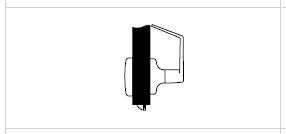
Corridor Lock: Outside knob requires a key. The can be locked by a button, the button will automatically release when inside knob is turned or door is closed. When locked with a key, the inside automatic release button is made inoperative and must be manually unlocked by a key.
Dummy Trim: For non-operational knobs used for decorative trims.

G
Grade of locks - To help identify the quality and durability of locksets and deadbolts, the American National Standards Institute (ANSI) has established three grades or standards for door locks. Each product must pass a series of operational and security tests.
Grade 2 - Meets light commercial and exceeds residential building requirements. Exceeds standard residential security requirements.
Grade 2 Deadbolts = 150,000 cycles, 5 door strikes (hammer test).
Grade 3 - Meets residential building requirements only. Provides minimal residential security.
Grade 3 Deadbolts = 100,000 cycles, 2 door strikes (hammer test).
Hand (Handing) of door - The description of swinging door operation, always viewed from outside the room, building, and so forth. Left hand means that the door hinges on the left and right hand means that the door hinges on the right.
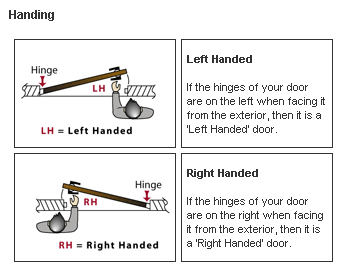
Handleset - A lockset/deadbolt which is keyed on one side, requiring a key to lock or unlock from exterior and usually a thumbturn or pushbutton to unlock from interior. Single Cylinder is used in most residential locations.
Hold Open Arm
Most door closer arms are
available in a hold open version. Usually they work by friction. Opening
the door to a certain degree tightens a nut which causes the arm to
stick at a point, holding the door open.
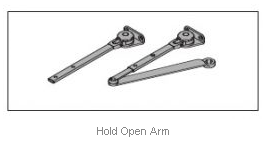
Hinges - The main piece of hardware that allows your door to swing in our out. Attaches to the door and door-frame. Different features include:
Butt Hinge: The standard hinge type, allows the door to be manually swung open or closed.
Spring Hinge: A small spring inside the hinge body allows the door to automatically swing closed.
Clamp Flange. A spring hinge flange which wraps around the edge of the door and is fastened with thru-bolts and nuts.
Double Acting. When a door is so arranged to swing in either direction.
Fall Mortise. When one hinge flange or leaf is mortised into the edge of the door and the other to the mortise cutout of the frame.
Full Surface. When one hinge flange or leaf is fastened to the surface of the door and the other to the surface of the frame.
Gravity Pivot Hinge. A pivot hinge arranged so the weight of the door causes it to close from an open position or open from a closed position. They are not listed for use on fire doors.
Half Mortise. When one hinge flange or leaf is mortised into the butt edge of the door and the other to the surface of the frame.
Half Surface. When one hinge flange or leaf is fastened to the surface of the door and the other to the mortise cutout of the frame.
Single Acting. When a door swings in one direction only.
Spring Hinge. A hinge with flanges or leaves which attach to the door and jamb and are connected to the hinge pivot point(s) (barrel). Springs provide energy to close a door from the open position or, in some cases, open a door from the closed position. Single acting spring hinges are often listed for use on fire doors.
I
Interconnected
Lock. (Also known by a number of different trade names) A lock
having a separate latch and dead bolt mechanically interconnected and
installed in round bored openings in the face and edge of a door. It is
best known for providing dead bolt security with the life safety feature
of simultaneous retraction. When the dead bolt is projected, a single
turn of the inside knob retracts both the dead bolt and the latch bolt.
This simultaneous retraction function is also available with some functions
of mortise locks.
K
Keying - The various keying arrangements for pin-tumbler cylinders:
Keyed Alike - all cylinders may be operated by the same key (not to be confused with master keyed);
Keyed Different - a different individual key operates each cylinder (or group of cylinders);
Master Key - a key to operate a group of cylinders, each of which may be set to a different individual key;
Master Keyed - all cylinders in a group can be operated by one master key, although all cylinders may be keyed differently (not to be confused with keyed alike).
Keyway - The channels or grooves in a lock that the key must pass through that distinguish one type of lock cylinder from another. Also called a "Profile".
Key Blank - Uncut keys before they are cut into a working key.
Keyed Different - A different individual key operates each cylinder (or group of cylinders).
L
Latch - The locking in of a circuit by means of a holding contact; used in relay logic when a momentary initiation is required.
Latch Protector - A device fastened to the door or frame that prevents access to the latch so it cannot be pried or forced back. Also known as a "Latch Protector", "Latch Guard", or a "Blocker Plate".
Latchbolt - A spring operated bolt with a beveled face to permit a latching action when the door closes.
Lock - A device for securing a door in the closed position against unauthorized or forced entry. It requires actuation to project or to retract its bolt.
Lockset - A locking device, complete with trim, mounting hardware and strike.
M
Master Keyed - Master Keyed (MK) - A master-keyed system involves each lock having its own individual key which will not operate any other lock in the system, but where all locks can be operated by a single master-key. This is usually applied in commercial environments.To organize a set of locks typically where each lock opens with it\'s own different key, yet one key will also open all the locks, allowing selective entry to doors to certain users.
Mortise - Pertaining to a method of installation in which only the face plate and trim is exposed. The lock case is installed in a pocket in the door or drawer.
Mortise Dead Lock. An auxiliary lock having a deadbolt instead of a dead latch and otherwise the same as a mortise dead latch.
Mortise Dead Latch. An auxiliary lock fitting a cavity prepared in the edge of the door and having a dead latch operated by a key or thumbturn both. The key or thumbturn engages the lock through holes prepared in the faces of the door.P
Padlock - A detachable and portable lock with a shackle which locks into its case.
Panic-proof locks - Locks that provide immediate exit from the inside at all times.
Passage - This style of hardware is used to provide transition from one room to the other. No locking function is included. Common applications are: Hallways, Closets, and Guest Rooms.
Pin Tumbler Mechanism - Small sliding pins in a lock cylinder that work against coil springs. They prevent the cylinder plug from rotating until the appropriate length pin is raised to the proper height by corresponding notch depth cut in the key. Pin tumblers usually consist of bottom pins, top pins and master pins. Most key operated locks provide limited access through the use of pin tumblers.
Privacy - This style of hardware is used to secure the interior rooms of a residence. They are locked by either a thumb turn or a pushbutton on the inside. An emergency key is the only way to unlock the door from the exterior, and is provided with each model. Common applications are: Master Bedrooms, Bathrooms, Offices/Dens.
R
Rekey - Generally entails disassembling a lock to replace the pins or tumblers inside. Once completed, the lock requires a different key to operate than before.
Rim Exit Device - a mechanical lock applied to the surface of the door that is operated from the inside of an outward swing door through the use of a crossbar or push rail extending at least halfway across the width of the door.
Rim Mounted - A device that is mounted on the surface of the door rather than installed within the door itself.
Rose or Rosette - A circular trim plate attached to the door under the knob or lever.
S
Self-Closing - Whenever opened, a door returns to the closed position. Accomplished with any labeled or listed closing device or spring hinge.
Shear Line - The area where the top surface of the plug and the cylinder housing meet. The height which the bottom pins must be raised by the key in order to rotate the key cylinder. Usually a cylindrical shaped tumbler which is often bullet shaped and comes in a variety of lengths that correspond to the depth of the cut of the notch in the key.
Spindle - Bar which connects knobs or levers through the door and operates the lock mechanism. Usually a cylindrical shaped tumbler which is often flat on both ends and is installed directly under a coil spring in the spring stack.
Split Finish - Interior and exterior finishes of are different. Used in coordinating different decor in adjoining rooms.
Springlatch - A plain latch with a beveled latch-bolt that is activated by springs.
Strike - A plate mortised into or mounted on the door jamb to accept and restrain a bolt when the door is closed. In some metal installations of a deadlock, the strike may simply be an opening cut into the jamb. (Synonym: keeper.)
Strike Plate - A metal plate affixed to a door jamb with a hole or holes for the bolt of the door. When the door is closed, the bolt extends into the hole in the strike plate, and holds the door closed. The strike plate protects the jamb against friction from the bolt, and increases security in the case of a jamb made of a softer material, such as wood.
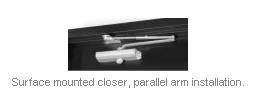
Tailpiece. A bar projecting from the back of a rim or bored lock cylinder engaging the lock mechanism and when rotated by the key or thumbturn either locks or unlocks.
Thumbturn.
The component that projects or retracts a dead bolt or latch bolt by grasping
with the thumb and fingers and turning. Sometimes called a turnpiece or
turn.
V
Volt (V) - A unit of electromotive force. It is the difference of potential required to make a current of one ampere flow through a resistance of one ohm.
Voltage - The term most often used (in place of electromotive force, potential, potential difference, or voltage drop) to designate electrical pressure that exists between two points and is capable of producing a flow of current when a closed circuit is connected between the two points.



